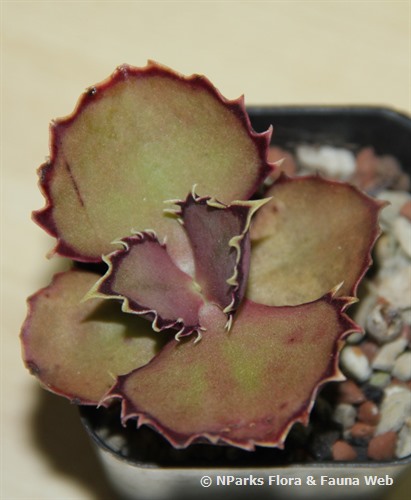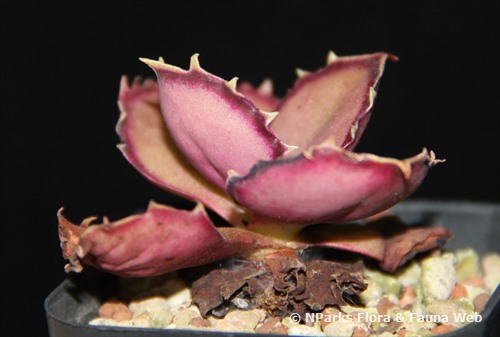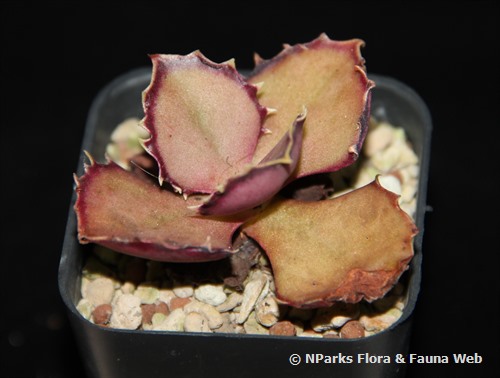
Back
Kalanchoe synsepala Baker
| Family Name: | Crassulaceae |
| Synonyms: | Kalanchoe brachycalyx Baker, Kalanchoe gentyi Raym.-Hamet & H. Perrier, Kalanchoe trichantha Baker |
Name
Classifications and Characteristics
| Plant Growth Form | Succulent Plant |
|---|---|
| Lifespan (in Singapore) | Perennial |
Biogeography
| Native Distribution | Madagascar |
|---|---|
| Native Habitat | Terrestrial |
| Preferred Climate Zone | Tropical, Sub-Tropical / Monsoonal |
Description and Ethnobotany
| Growth Form | Stolon forming erect herb to 30cm tall |
|---|---|
| Foliage | Leaves light green to dull olive green or flushed with red, margins red - maroon, dentate. |
| Flowers | Flowers white, tinged with pink |
Landscaping Features
| Desirable Plant Features | Ornamental Foliage, Ornamental Form |
|---|---|
| Landscape Uses | Small Gardens, Interiorscape/ Indoor Plant, Container Planting, Suitable for Hanging Baskets |
| Usage Hazard - Cons | Toxic Upon Ingestion |
| Usage Hazard - Cons Remarks | Contains cardiac glycosides that are similar to those found in Digitalis sp.; toxic to small animals, pets & livestock |
Fauna, Pollination and Dispersal
| Pollination Method(s) | Biotic (Fauna) |
|---|
Plant Care and Propagation
| Light Preference | Full Sun, Semi-Shade |
|---|---|
| Water Preference | Moderate Water, Little Water |
| Plant Growth Rate | Moderate |
| Rootzone Tolerance | Drought Tolerant, Well-Drained Soils, Low Humidity / Aircon, Disease / Pest Resistant, Easy to Grow |
| Transplanting Tolerance | Good |
| Maintenance Requirements | Low |
| Pest(s) | Sucking Insects |
| Propagation Method | Seed, Stem Cutting |
Foliar
| Foliage Retention | Evergreen |
|---|---|
| Mature Foliage Colour(s) | Brown, Green, Red |
| Mature Foliage Texture(s) | Smooth, Hairy / Hirsute |
| Foliar Modification | Storage Organ |
Floral (Angiosperm)
| Flower Colour(s) | Pink, White |
|---|---|
| Flower Grouping | Cluster / Inflorescence |
| Flowering Period | Photoperiodic |
Image Repository
Others
| Master ID | 31015 |
|---|---|
| Species ID | 5402 |
| Flora Disclaimer | The information in this website has been compiled from reliable sources, such as reference works on medicinal plants. It is not a substitute for medical advice or treatment and NParks does not purport to provide any medical advice. Readers should always consult his/her physician before using or consuming a plant for medicinal purposes. |







